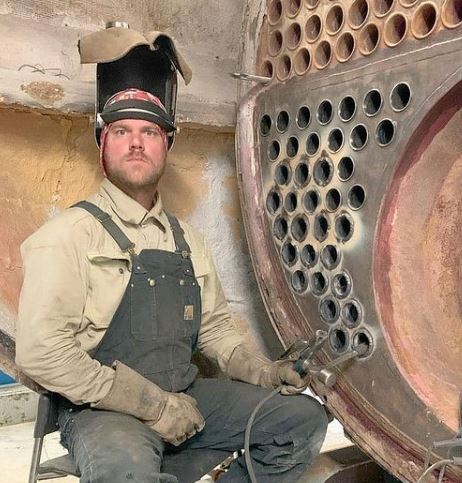Tig Welding is a specialized form of welding that uses a non-consumable tungsten electrode to produce the weld and an inert gas, such as argon, to shield the weld area from contamination. In the food processing industry, tig welding is often used for welding stainless steel and other high-grade materials and creating small, intricate welds that must meet strict quality standards.
This comprehensive guide will provide an overview of the tig welding process and its key considerations for use in the food processing industry.

Tig Welding for Food Processing
In this article, we will provide expert tips and techniques for Tig Welding Food Processing, focusing on achieving the highest level of accuracy and cleanliness.
Materials and Equipment
Tig welding is often used in the food processing industry to manufacture and repair equipment such as conveyor belts, storage tanks, and processing vessels. The materials used in food processing equipment must withstand harsh cleaning chemicals, high temperatures, and mechanical stresses, making tig welding an ideal choice due to its ability to produce strong and durable welds.
The materials commonly used in food processing equipment include stainless steel, aluminum, and carbon steel. Stainless steel is popular due to its corrosion resistance, while aluminum is often used for its lightweight and corrosion-resistant properties. Carbon steel can also be used but may require additional protection against corrosion.
When selecting tig welding equipment for food processing applications, it is important to choose equipment designed for the specific materials and thicknesses being welded. The tig torch, filler rod, and shielding gas play important roles in the welding process and must be chosen carefully. It is also important to ensure that the equipment is properly maintained and calibrated to ensure consistent and high-quality welds.
Tig Welding Techniques
Tig welding requires a skilled operator to produce high-quality welds, and several techniques can be used to achieve the desired result. The technique chosen will depend on the materials being welded, the common type, and the position of the weld.
Before beginning the welding process, it is important to prepare the materials by cleaning them thoroughly to remove any contaminants that could impact the quality of the weld. The materials should also be fitted and clamped together properly to ensure a consistent and strong weld.
To produce a tig weld, the operator will use the tig torch to heat the base metal and the filler rod to add filler material to the weld. The shielding gas protects the weld pool from contaminants in the air.
Several types of joints can be welded using tig welding in food processing applications, including butt joints, corner joints, and lap joints. The technique used to weld these joints will vary depending on the application’s specific requirements.
Quality Control and Safety Considerations
In the food processing industry, it is essential to maintain high levels of quality control to ensure the safety and integrity of the final product. Tig welding can impact product safety if the welds are not properly executed, as faulty welds can lead to equipment failure and potential product contamination.
To ensure the quality and safety of tig welds in food processing applications, it is important to implement several quality control measures. These can include visual inspection of the welds, non-destructive testing methods such as ultrasonic or radiographic testing, and thorough documentation of the welding process.
In addition to quality control, it is important to consider safety when tig welding in the food processing industry. Welding can produce several hazards, including the risk of burns, electric shock, and exposure to harmful fumes. It is important to use the appropriate personal protective equipment (PPE) and implement hazard control measures such as ventilation and fire prevention to protect workers.
Maintenance and Repair
Proper maintenance and repair of tig welded equipment are essential to ensure the safety and efficiency of food processing operations. Regular inspections should be conducted to identify any issues with the equipment, and repairs should be made promptly to prevent equipment failure and downtime.
Common issues with tig welded equipment in food processing applications include corrosion, wear and tear, and fatigue. To prevent these issues, it is important to use the appropriate materials and techniques for the specific application and to properly maintain and repair the equipment as needed.
What Are The Types Of Tig?
There are two main types of TIG welding: DC TIG and AC TIG.
DC TIG welding uses direct current (DC) to create the arc between the tungsten electrode and the workpiece. In DC TIG welding, the electrode is connected to the negative terminal of the power source, and the workpiece is connected to the positive terminal. The direct current creates an electric arc that melts the base metal and filler metal, allowing them to be joined together. DC TIG welding is typically used for ferrous metals, such as steel and cast iron.
AC TIG welding uses alternating current (AC) to create the arc between the tungsten electrode and the workpiece. In AC TIG welding, the electrode is connected to one power source terminal, and the workpiece is connected to the other terminal. The alternating current creates an electric arc that melts the base metal and filler metal, allowing them to be joined together. AC TIG welding is typically used for non-ferrous metals, such as aluminum, magnesium, and copper.
What Is Tig Welding Mainly Used For?
The ability to control the heat input and filler metal addition makes TIG welding well-suited for welding thin materials, as it allows the welder to avoid overheating the material and causing distortion. It is also a precise process that produces clean, strong welds, making it a good choice for welding high-quality, precision joints.
TIG welding is also used for welding dissimilar metals, such as aluminum to steel or stainless steel to brass. The ability to control the heat input and filler metal addition makes it possible to weld these materials without causing cracking or other problems.
Finally, TIG welding is often used for repairing welds, as it allows the welder to make precise, clean welds that are strong and free of defects.
What Is Tig Material?
The base metal is the material that is being welded. It can be made of various materials, including steel, aluminum, magnesium, and other alloys.
The filler metal is a material that is used to fill the joint between the base metal pieces. It is typically made of the same material as the base metal but can also be made of a different material if necessary. The welder adds the filler metal to the weld joint, which is melted by the arc’s heat to create the weld.
The tungsten electrode is a non-consumable electrode used to create the arc in TIG welding. It is made of tungsten, a highly conductive and heat-resistant material. The tungsten electrode is not consumed during the welding process and is used to create the arc between the electrode and the workpiece.
What Are The Characteristics Of Tig Welding?
TIG welding is a high-quality welding process that produces clean, strong welds with minimal distortion. It is a precise process that allows the welder to control the heat input and the filler metal addition, making it suitable for welding thin materials and precision joints.
Some of the other characteristics of TIG welding include the following:
- High-quality welds: TIG welding produces clean, strong welds with minimal defects, making it a good choice for critical applications.
- Precision: TIG welding allows the welder to control the heat input and filler metal addition, making it possible to produce precise, high-quality welds.
- Minimal distortion: TIG welding produces minimal distortion, making it a good choice for welding thin materials and precision joints.
- Versatility: TIG welding can be used on many materials, including steel, aluminum, magnesium, and other alloys.
- Welds with good appearance: TIG welding produces welds with a smooth, shiny appearance that is attractive for certain applications.
- High-quality welds: TIG welding produces clean, strong welds with minimal defects, making it a good choice for critical applications.
Conclusion
In conclusion, tig welding is a popular and effective method for manufacturing and repairing food processing equipment due to its high precision and ability to produce strong and durable welds. To ensure the quality and safety of tig welded equipment in the food processing industry, it is important to implement quality control measures and follow proper safety protocols. Looking towards the future, tig welding will continue to be a vital part of the food processing industry, with advancements in technology and techniques likely to further improve the efficiency and effectiveness of this welding method.

It’s been years since I got into welding as a side hustle. It’s been so long since Doing All kinds of welds for business and pleasure as this is my hobby. Being in this field I have learned from hands-on-experience also came to know what gears work and what doesn’t. The Tig Welder is my own platform where I use to share my experience.






Leave a Reply